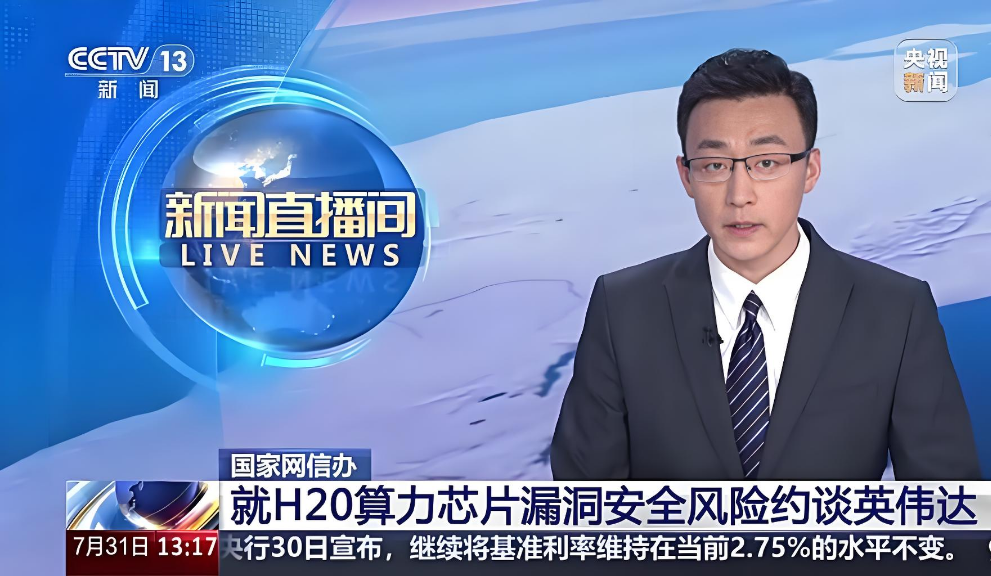China’s Cyberspace Administration Takes Aim at “Chip Backdoors”! Nvidia H20 Faces Security Talks, US-China Computing Power Shadow War Escalates
July 31, 2025 – China’s Cyberspace Administration of China (CAC), acting under the Cybersecurity Law, Data Security Law, and Personal Information Protection Law, summoned Nvidia Corporation for talks. This follows the exposure of “vulnerability backdoors” in Nvidia’s H20 computing chips, involving “location tracking” and “remote shutdown” capabilities.
An internal CAC notice indicated that once activated, the H20 backdoor could “penetrate all major Chinese cloud and AI computing centers,” directly threatening critical infrastructure like power grid dispatch and financial systems.
90-Day Deadline: 1,100 institutions nationwide that have already purchased the chips (including state-owned banks and the three major cloud providers) have been ordered to complete a four-level security inspection covering “chip-firmware-system-data link” within 90 days, or face mandatory shutdown!
 (Image source: CCTV News)
(Image source: CCTV News)
Previously, US lawmakers had publicly advocated for mandating such technologies in export chips, and US AI experts confirmed Nvidia’s related technology was mature.
The CAC demanded Nvidia provide detailed explanations and supporting evidence regarding the security risks, ensuring the data security and network safety of Chinese users.
“China-Specific” Chips: The H20 is a downgraded AI chip designed by Nvidia to comply with US export restrictions to China. Based on the Hopper architecture, its performance is suitable for vertical-specific model training but cannot support trillion-parameter large models. Its overall performance is slightly higher than the domestic Shengteng 910B chip.
Full H20 Chip Incident Timeline:
- Late 2023 – [Nvidia develops the H20 “China-specific version” chip based on the Hopper architecture to comply with US export controls to China] – [H20 performance is significantly lower than the flagship H100 chip but meets US control requirements. Priced at $10,000-$12,000, it became the highest-performance AI chip available on the Chinese market at the time.]
- April 2025 – [The US government suddenly relists the H20 on the export control list, banning sales to China] – [Nvidia is forced to write off $5.5 billion in inventory, facing $15 billion in potential losses; AI deployment plans of Chinese tech firms are disrupted.]
- May 15, 2025 – [Eight US lawmakers propose the “Chip Security Act,” requiring mandatory embedding of “location tracking” technology in exported high-end AI chips and reporting of product location changes] – [The bill aims to strengthen tech containment against China, setting the stage for the subsequent H20 security controversy.]
- July 15, 2025 – [The US approves resumption of H20 exports to China; Nvidia CEO Jensen Huang visits China, announcing chip deliveries to Chinese clients, calling it “very good news”] – [Huang emphasized the importance of the Chinese market (home to 50% of global AI researchers) and revealed a 9-month supply chain recovery timeline.]
- July 29, 2025 – [White House Economic Advisor Hassett explains the reason for releasing H20: “To prevent China from leading the chip race,” highlighting US policy contradictions] – [The US believes China already has comparable domestic chips (e.g., Huawei’s Shengteng 910B), so releasing the H20 poses no threat.]
- July 30, 2025 – [Nvidia’s market capitalization reaches $4.37 trillion, becoming the world’s first company to surpass $4 trillion] – [The market was not significantly affected by security rumors, reflecting short-term capital optimism.]
- July 31, 2025 – [China’s CAC formally summons Nvidia, demanding explanations and proof regarding the security risks of “location tracking” and “remote shutdown” in H20 chips] – [Invoking the Cybersecurity Law, Data Security Law, and Personal Information Protection Law, it directly points to the threat posed by US-mandated backdoor technology to China’s data sovereignty and national security.]
The essence of this summons is a battle for control over computing power infrastructure – the H20 is merely a pawn in the US-China tech cold war.
Regardless of whether it passes security review, China’s determination to use this “vulnerability crisis” to accelerate domestic substitution is clearly etched into the code of Huawei’s Shengteng and the tape-outs of Cambricon. This incident forces a confrontation with the dilemma of balancing national security and industrial development within global tech collaboration.
Nvidia must directly address Chinese regulators’ doubts about “backdoor technology,” while China needs to accelerate the breakthrough of domestic computing chips. The aftermath of this event will profoundly impact the US-China tech rivalry and the global AI industry landscape.



